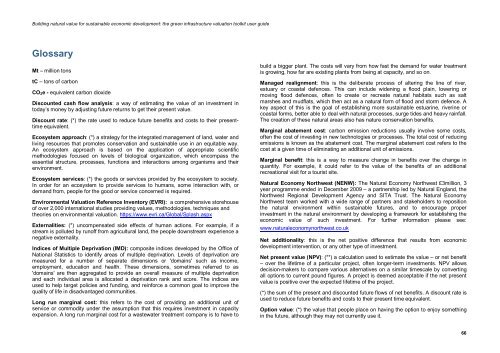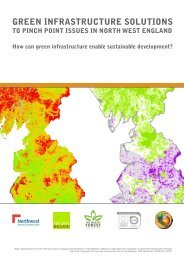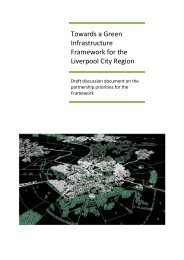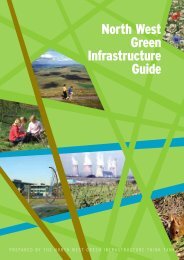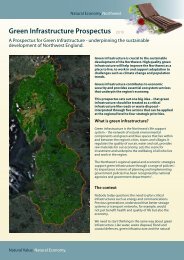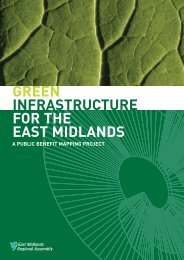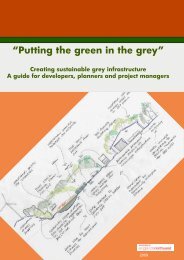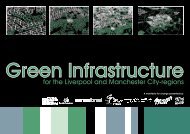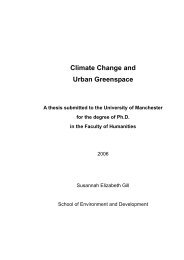The green infrastructure valuation toolkit user guide
The green infrastructure valuation toolkit user guide
The green infrastructure valuation toolkit user guide
Create successful ePaper yourself
Turn your PDF publications into a flip-book with our unique Google optimized e-Paper software.
Building natural value for sustainable economic development: the <strong>green</strong> <strong>infrastructure</strong> <strong>valuation</strong> <strong>toolkit</strong> <strong>user</strong> <strong>guide</strong><br />
Glossary<br />
Mt – million tons<br />
tC – tons of carbon<br />
CO 2e - equivalent carbon dioxide<br />
Discounted cash flow analysis: a way of estimating the value of an investment in<br />
today’s money by adjusting future returns to get their present value.<br />
Discount rate: (*) the rate used to reduce future benefits and costs to their presenttime<br />
equivalent.<br />
Ecosystem approach: (*) a strategy for the integrated management of land, water and<br />
living resources that promotes conservation and sustainable use in an equitable way.<br />
An ecosystem approach is based on the application of appropriate scientific<br />
methodologies focused on levels of biological organization, which encompass the<br />
essential structure, processes, functions and interactions among organisms and their<br />
environment.<br />
Ecosystem services: (*) the goods or services provided by the ecosystem to society.<br />
In order for an ecosystem to provide services to humans, some interaction with, or<br />
demand from, people for the good or service concerned is required.<br />
Environmental Valuation Reference Inventory (EVRI): a comprehensive storehouse<br />
of over 2,000 international studies providing values, methodologies, techniques and<br />
theories on environmental <strong>valuation</strong>. https://www.evri.ca/Global/Splash.aspx<br />
Externalities: (*) uncompensated side effects of human actions. For example, if a<br />
stream is polluted by runoff from agricultural land, the people downstream experience a<br />
negative externality.<br />
Indices of Multiple Deprivation (IMD): composite indices developed by the Office of<br />
National Statistics to identify areas of multiple deprivation. Levels of deprivation are<br />
measured for a number of separate dimensions or 'domains' such as income,<br />
employment, education and health. <strong>The</strong>se dimensions, sometimes referred to as<br />
'domains' are then aggregated to provide an overall measure of multiple deprivation<br />
and each individual area is allocated a deprivation rank and score. <strong>The</strong> indices are<br />
used to help target policies and funding, and reinforce a common goal to improve the<br />
quality of life in disadvantaged communities.<br />
Long run marginal cost: this refers to the cost of providing an additional unit of<br />
service or commodity under the assumption that this requires investment in capacity<br />
expansion. A long run marginal cost for a wastewater treatment company is to have to<br />
build a bigger plant. <strong>The</strong> costs will vary from how fast the demand for water treatment<br />
is growing, how far are existing plants from being at capacity, and so on.<br />
Managed realignment: this is the deliberate process of altering the line of river,<br />
estuary or coastal defences. This can include widening a flood plain, lowering or<br />
moving flood defences, often to create or recreate natural habitats such as salt<br />
marshes and mudflats, which then act as a natural form of flood and storm defence. A<br />
key aspect of this is the goal of establishing more sustainable estuarine, riverine or<br />
coastal forms, better able to deal with natural processes, surge tides and heavy rainfall.<br />
<strong>The</strong> creation of these natural areas also has nature conservation benefits.<br />
Marginal abatement cost: carbon emission reductions usually involve some costs,<br />
often the cost of investing in new technologies or processes. <strong>The</strong> total cost of reducing<br />
emissions is known as the abatement cost. <strong>The</strong> marginal abatement cost refers to the<br />
cost at a given time of eliminating an additional unit of emissions.<br />
Marginal benefit: this is a way to measure change in benefits over the change in<br />
quantity. For example, it could refer to the value of the benefits of an additional<br />
recreational visit for a tourist site.<br />
Natural Economy Northwest (NENW): <strong>The</strong> Natural Economy Northwest £3million, 3<br />
year programme ended in December 2009 – a partnership led by Natural England, the<br />
Northwest Regional Development Agency and SITA Trust. <strong>The</strong> Natural Economy<br />
Northwest team worked with a wide range of partners and stakeholders to reposition<br />
the natural environment within sustainable futures, and to encourage proper<br />
investment in the natural environment by developing a framework for establishing the<br />
economic value of such investment. For further information please see:<br />
www.naturaleconomynorthwest.co.uk<br />
Net additionality: this is the net positive difference that results from economic<br />
development intervention, or any other type of investment.<br />
Net present value (NPV): (**) a calculation used to estimate the value – or net benefit<br />
– over the lifetime of a particular project, often longer-term investments. NPV allows<br />
decision-makers to compare various alternatives on a similar timescale by converting<br />
all options to current pound figures. A project is deemed acceptable if the net present<br />
value is positive over the expected lifetime of the project.<br />
(*) the sum of the present and discounted future flows of net benefits. A discount rate is<br />
used to reduce future benefits and costs to their present time equivalent.<br />
Option value: (*) the value that people place on having the option to enjoy something<br />
in the future, although they may not currently use it.<br />
66


